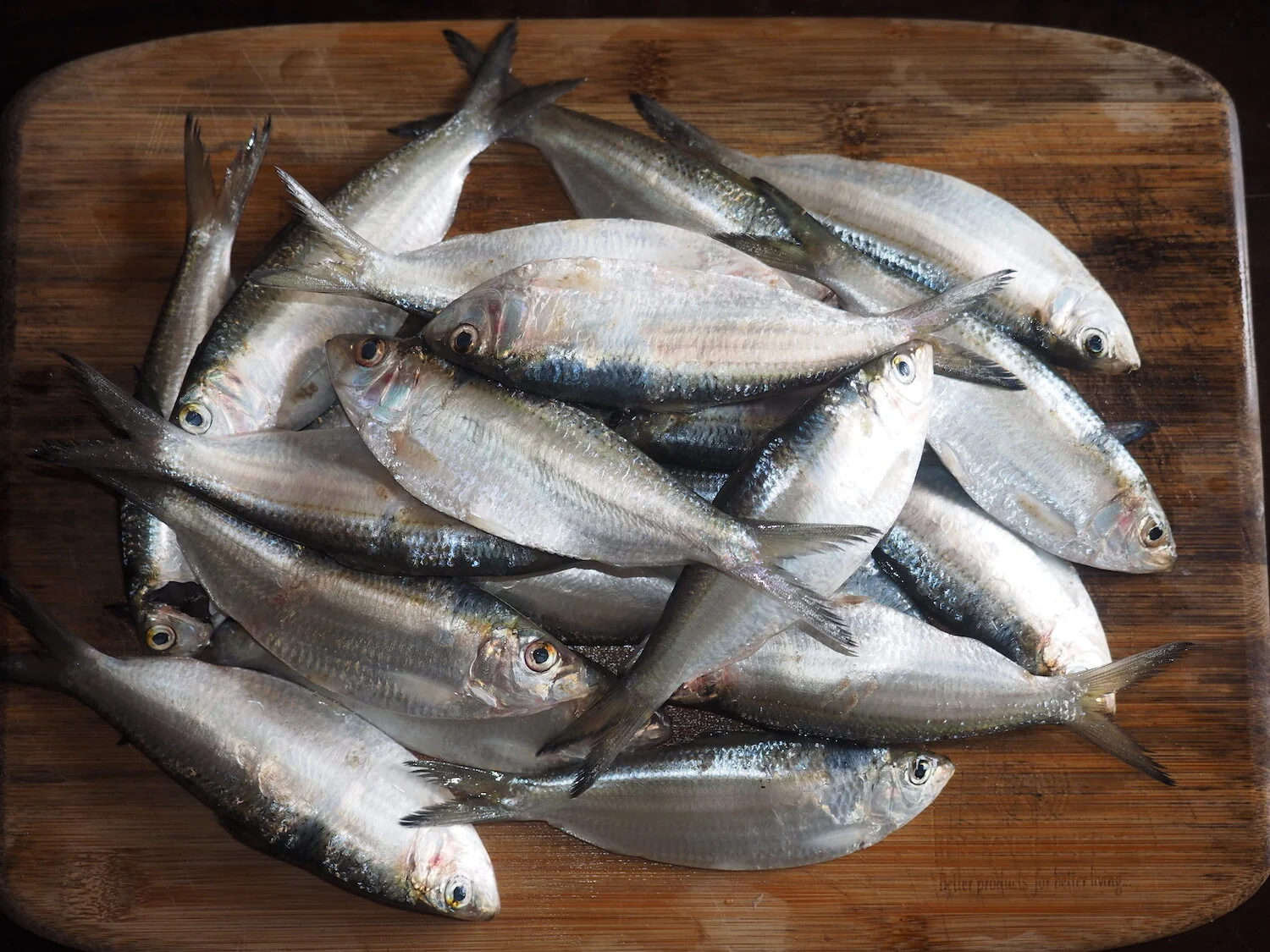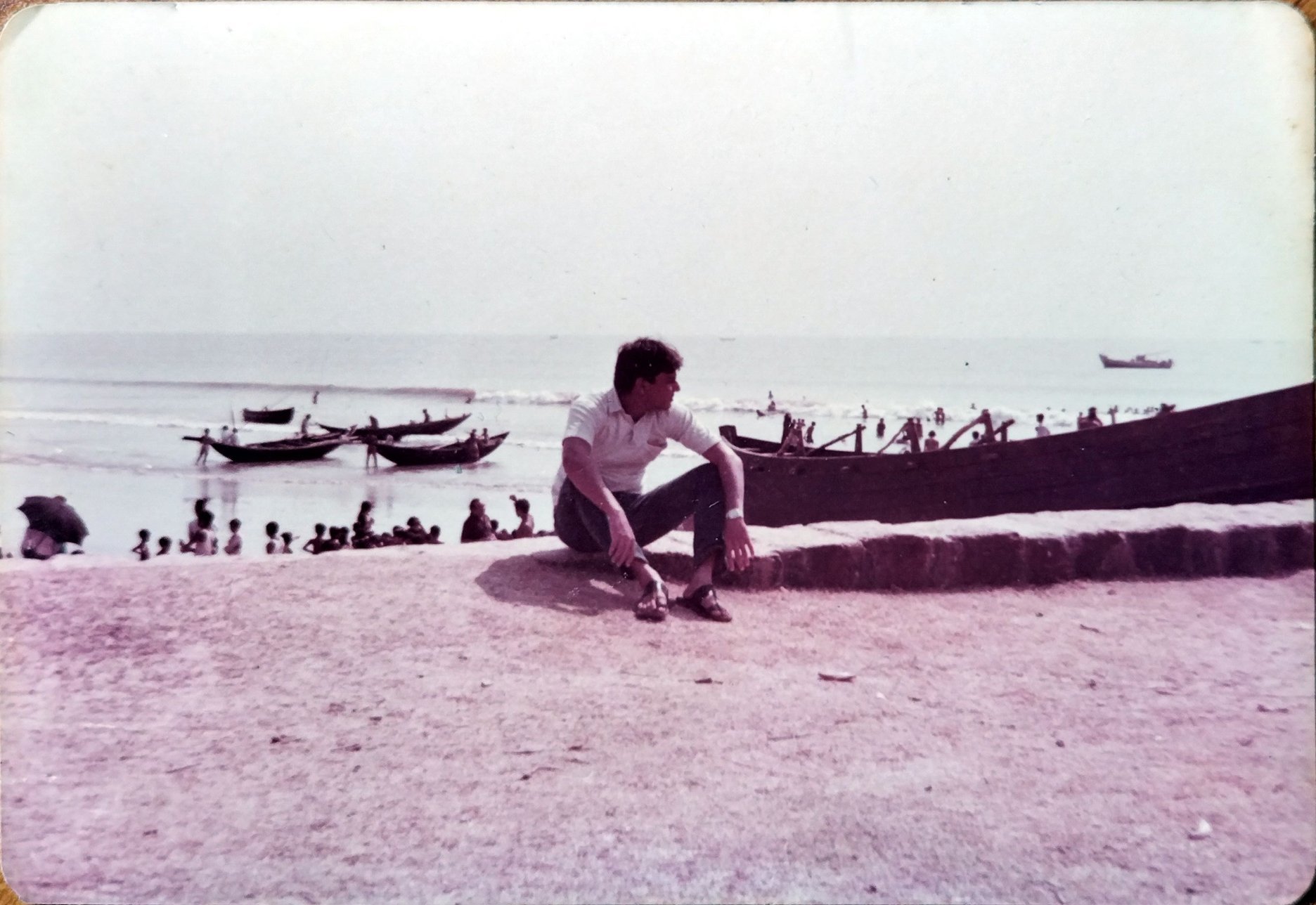Teflachem Humón: The Story of a Fish and A Berry

Aaron Savio Lobo writes about the relationship between the tefflan berry (a close cousin of the Sichuan peppercorn), the spawning season for several Indian oily fish, and the wonderful dish made with the two.
Fringescale sardinella, pedve in Konkani, is a good candidate for this curry
There are several ways to prepare a good Goan fish curry, but one of my favourites is teflachem humón, a delicious Goan Hindu-style preparation. Humón or koddi is the Konkani word for curry, and tefflan (also known as tirphal, teppal; chiphal in Marathi; and tejphal in Hindi) are peppercorn-like berries, from the Indian Prickly Ash (Zanthoxylum rhetsa), a forest tree common in Goa’s Western Ghats as well as many other parts of the Indian sub-continent. The tree is easily recognisable by its white corky bark studded with large conical thorns. It has a beautiful shiny green crown of leaves, which it begins to shed as the weather begins to warm up.
Reminiscent of the Pac-Man video game, the berry’s husk imparts a unique citrusy zing to the curry, which marries well with other spices including chillies, turmeric, tamarind, kokum and coconut milk, both wild or locally cultivated. The species belongs to the citrus family that also includes lemons, limes, grapefruit, oranges etc. Biting into a fresh husk can leave the tongue and lips tingling and numb. The tingly-numbing sensation is attributed to compounds called sanshools present in the husks. In fact, the well-known ‘ma la’ flavour (In Cantonese, ‘ma’ is to numb, and ‘la’ means spicy), signature to Chinese Sichuan cuisine, is actually attributed to the Sichuan pepper Zanthoxylum simulans, a close cousin of the tefflan. This spice is best paired with oily fish like the Indian mackerel, oil sardine and the smaller tuna species, as the acids in the berry, along with those along with those of the tamarind and kokum significantly cut through the fishy flavours typical to some of these fish. However, it is best not paired with larger, less ‘fishy’ varieties such as Silver Pomfret or freshwater fish, as the berry quickly overpowers their more delicate flavours.
Tefflan berry husks
In Goa, and along other parts of the Konkan, the naked (leafless) tree begins to sprout a shiny new flush of leaves by the end of April. This is followed quickly by the blooming of flowers, and then fruits. The berries, borne in bunches, are collected and dried. The dried dark olive green berries are then used year round. They are however, at their most flavourful when bright green and fresh, as the sanshools begin to decompose when exposed to moisture and the sun’s UV rays. It is interesting that this time of year also coincides with the ripening of other fruits and spices that are essential for teflachem humón curry. For example, the kokam fruit also begins to ripen in late April.
And it isn’t just the berry and the spices, the spawning season for oily fish like the Indian mackerel and sardine in the Arabian Sea, also peak around the same time (mid-April onwards). Although these fish lay their eggs in the open ocean, the South West monsoon winds and the corresponding oceanic currents transport them to the more sheltered coastal waters, which increase their chances of survival. The upwelling currents typical to this season churn up nutrients from the depths of the ocean, bringing them to the surface and allowing phytoplankton (microscopic marine algae), the major food of these species, to bloom while the resulting fish populations flourish. The end of summer marks the end of the fishing season along the West coast, as the winds pick up and churn the seas. In the decades before industrial fishing in Goa (1970’s), large schools of these surface-swimming fish would venture into nearshore waters, and mouth of the Mandovi and Zuari rivers during this time of the year. Here, they were caught using traditional fishing methods such as the rampon (shore seines) and maag, the floating gill nets used to catch surface shoaling species.
The use of the tefflan berry goes beyond its culinary value. It is known that plants evolved a range of aromatic compounds as a strategy to keep predators and pests at bay. The same is probably true for the Zanthoxylums. Tefflan berries are known to have a range of alkaloids and essential oils capable of hindering bacteria, parasitic worms and fungal infections, which probably helped earlier generations store curries longer without refrigeration. In Goa, the berries are added to stored paddy (rice) as they are known to keep away weevils, a common pest in these parts. The chemical extracts are also known to have antioxidants and pain alleviating compounds, among many others. The Kanikkar tribe of the southern Western Ghats of Kerala and Tamil Nadu prepare a paste from the iraccai (tefflan in Tamil) tree spines, which is used to relieve breast pain (mastitis) and improve milk production in lactating mothers.
The thorny bark of a mature Indian Prickly Ash
The bark of a young Indian Prickly Ash
I learnt that the relationship between this tree and fish go beyond just our Goan fish curry. A fish poison (piscicide) is made by grinding the bark, leaves and seeds of the tree, then used to capture river fish by communities in the Western Ghats. These natural piscicides, unlike chemicals, do not persist in the fish, and are now being used in fish farms to free ponds of invasive or predatory fish, before introducing the target species.
There are approximately 250 species of Zanthoxylum distributed throughout the tropics (but also in North America and East Asia), and they seem to constitute an important spice wherever they occur. Zanthoxylum armatum, common in the Himalayas and known by its Nepali name timur, is also called the toothbrush tree. The young branches are used as teeth cleaning twigs and are known to numb toothaches. This species also makes for great cooking. In Uttarakhand the Jaunsari-Bawar communities of Garhwal prepare their own version of fish curry using native river fish such as mahseer and kalbasu, cooking it with the leaves and berries of the Timur tree, along with other ingredients collected from nearby forests. In Sikkim and North Bengal, timur is an important ingredient in the chutney accompanying momos, and is made using tomatoes, Dalle chillies (cherry peppers) with timur and bhangjeera (perilla seeds). The Batak pepper, andalamin, are the berries of Zanthoxylum acanthopodium, endemic to the highlands of North Sumatra. It is one of the main spices used by the Batak tribes in the region and is the key ingredient in a steamed fish preparation called arsik and the list goes on.
Indian mackerel and squid being sold by a local fish monger
The tefflan berries constitute a Non-Timber Forest Produce (NTFP). NTFPs are the goods and services obtained from a forest that exclude timber. Wild edibles such as mushrooms, bamboo shoots, tubers, yams, fruit, fish, honey, game, are all included in this category. These species are not just important to indigenous forest dwellers, they are crucial to biodiversity conservation and to the food security of society at large. While the tefflan tree continues to be common in Goa’s forests, the state has witnessed a rapid change in its native forest cover since the 1980s, primarily driven by activities such as mining and monoculture plantations of cash crops such as cashew, and more recently, rubber. This has come at a huge cost to the ecosystem and a host of services they provide.
While these changes transpire in Goa’s hinterland and ghats (hills), the coastline and the nearshore waters have undergone a sea change. Fisheries in the region have become increasingly unsustainable, and the warming of oceans triggered by climate change is effecting them in more ways than one. While fish like the Indian mackerel and sardine are considered to be relatively resilient, warming oceans is leading to a shift in their plankton supply to cooler waters northwards, which the fish follow in close pursuit. This has led to crashes in the catch, more recently. Moreover, sustained industrial fishing operations such as purse-seining capture tonnes of these oily fish. However, rather than being consumed by humans, large portions are dried and ground to fishmeal to feed the burgeoning poultry and aquaculture industries in the country. This deprives already impoverished coastal communities of a crucial source of protein.
The loss of biodiversity ultimately translates to a loss of diversity in our diets, crucial to our health and wellbeing. This also signals a pernicious, often silent decline in our Traditional Ecological Knowledge systems, which will most definitely have an impact on our heirloom cuisine and recipes.
Aaron Savio Lobo is a marine conservation scientist, and a member of the IUCN SSC Marine Conservation Committee. You can follow his work here.
All photographs by Aaron Savio Lobo.
ALSO ON THE GOYA JOURNAL












